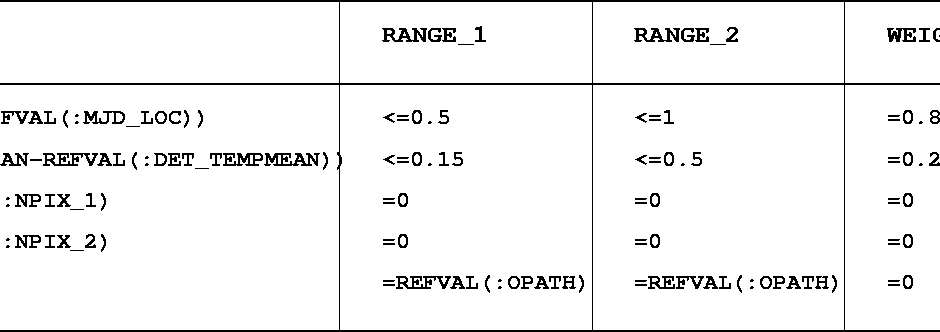



Next: Association of Calibration Exposures
Up: Association of images
Previous: Creation of the Association
Table 15.8 shows a table of association rules that has been
created to associate bias exposures with scientific frames.
A column labeled :MJD_LOC has been created in the OST and contains a number
derived from the Modified Julian Date of the exposure.
- ABS(:MJD_LOC-REFVAL(:MJD_LOC)) is the absolute difference between
the time of the scientific frame that is being studied and the time
of a dark exposure
- ABS(:DET_TEMPMEAN-REFVAL(:DET_TEMPMEAN)) is the absolute difference
between the mean temperature of the detector when the dark exposure was taken
and the mean temperature of the detector when the scientific frame was observed.
- :NPIX_1-REFVAL(:NPIX_1) is the difference between the CCD window
sizes in the X-direction of a dark exposure and the scientific frame while
:NPIX_2-REFVAL(:NPIX_2) is the difference between the CCD window sizes in the Y-direction of a dark exposure and the scientific frame.
Each row of the column labeled :RANGE_1 defines the acceptable ``first choice"
ranges for each of the
four functions mentioned previously, and the combination of these four criteria
defines the ``first choice" set of criteria. This may be expressed as:
Given a scientific exposure, select all dark exposures that satisfy:
- The elapsed time between the two exposures is less than 12 hours
- The detector mean temperature did not vary by more than 0.15 degrees between
the two exposures
- The two frames have exactly the same size.
The column RANGE_2 defines in the same way the set of ``second choice"
criteria
that can be expressed as:
Given a scientific exposure, select all dark exposures that satisfy:
- The elapsed time between the two exposures is less than 12 hours
- The detector mean temperature did not vary by more than 0.5 degrees between
the two exposures
- The two frames have exactly the same size.
The graphs of Figure 15.2 illustrate the association of two dark
exposures with each of two scientific images from our observing run:
susi0006.bdf and susi0009.bdf.
The association process when applying the set of criteria mentioned above will
find two suitable candidates for susi0006.bdf satisfying the ``first choice" set of criteria. No ``first choice" candidates for susi0009.bdf will be found while
five ``second choice" candidates may be selected. Because more importance
is assigned to the time difference (weight=0.8) than to the detector temperature
difference (weight=0.2), the files susi0001.bdf and susi0002.bdf will be
flagged as the ``best" ones. (Note that the differences are computed in the
units involved in the columns involved. In the given example they are degrees
kelvin and days, respectively.)
A table of rules (Table 15.9) for associating flat-field exposures has been created
following the same scheme. One criterion has to be added to the rules
mentioned above:
One has to make sure that one associates only frames obtained
in the same instrument configuration (i.e in this case with the same filter).
Figure 15.3 shows that only one flat field can be associated with
the frame susi0006.bdf (for clarity, only the FFs obtained with the same filter
as the scientific image are numbered) while three suitable flat-fields may be
selected for susi0009.bdf
Table:
Rules for the association of DARK exposures (cf. Fig. 15.3 and 15.2)
 |
Table:
Rules for the association of FF exposures (cf. Fig. 15.3 and 15.3)
 |




Next: Association of Calibration Exposures
Up: Association of images
Previous: Creation of the Association
Petra Nass
1999-06-15
